2025-07-29
Synths!
… in which the author explains how he ended up with his current synthesizer setup. (This is a rambly one, I guess)
Synths?
For a decent amount of time now I have wanted to get back into making music. I used to play the trumpet in my teens and that was fun, but currently most music I like is made up of mostly synthesizers and/or electric guitars.
In theory, it's pretty easy to get into synthesizers, or so it seems. You can do it all in software, you see! Just install a DAW and a few synth plugins and go make some noise! But practice disagrees with theory. Nothing sucks the joy out of an interest quicker than having to wait for a slow splash screen to finally make way for a proper application window and having to wade through a deeply nested menu bar. Ewww. Just eww.
Both splash-screens and menu bars are among the UI trends I disagree with the most. How about you just open your main application window and display a loading screen rather than annoy me with a transient window? Why not just put all the buttons into places where they make sense (i.e. close to the thing they manipulate) rather than holding them hostage in a single, crowded space?
And I also don't really see myself having any fun drag'n'dropping MIDI notes and audio samples in a DAWs timeline… In fact, I was really hoping this would turn out to be an activity I could do without needing any computers…
In October 2024 I had saved up some play money (mostly because that year I had focused pretty hard on my computer related interests and I absolutely refuse to spend any money on computers if I can avoid it) and made an impulse purchase: I got myself a drum machine!
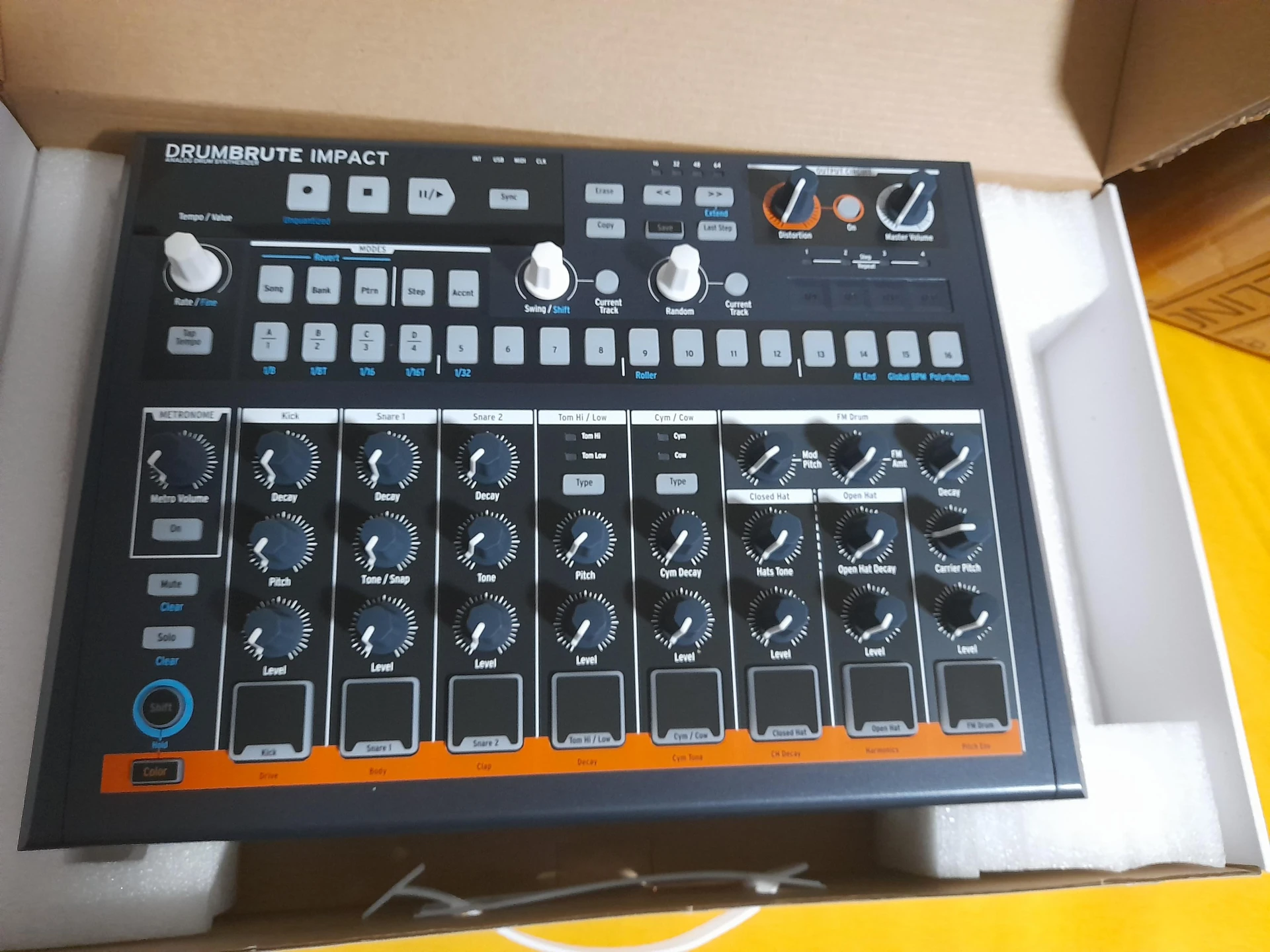
A "Drumbrute Impact" by Arturia. Not the name I would have chosen, the drums are actually pretty smooth and soft to my ears (in a good way), but I guess "Drumsmooth Firm but Gentle Touch" would not have sold as many units…
Anyway, I like this thing a lot. It is an analog synth and has a reasonable choice of instruments, with the minor exception that I would have preferred a second FM drum over a second snare and probably a second kick over the toms. It actually has more instruments than you first realize, because almost all have a "coloured" variant. The instruments also all respond to attack, even though the controls on the machine itself only expose two attack values: Yes and no.
It sounds very unlike the commonly loved drum machines: It is not all similar to either the analog drums from Korg or Roland, and definitely not to Rolands sampled drums. But I like the sounds it makes, so no complaints from me here.
Where it truely shines though is its built-in sequencer. With little effort you can create fun and complex rhythms. This is truely a masterpiece of UI/UX design, in my opinion.
Just sit down with the thing on your lap and some headphones and have fun! No computer needed at all!
A Detour into Software
Now, I actually wanted to make music with more than just percussion rhythms. Clearly my setup was missing more synths.
I decided I wanted a dedicated sequencer controlling MIDI synths. The idea being that this way I could get comfortable with one sequencers quirks while still having a wide variety of sounds and more possibilities for expansion and MIDI madness in the future.
During this time I had discovered the YouTube Channel Look Mum No Computer where the idea of custom MIDI instruments and MIDI-fying older/unusual instruments infected my brain. I have no idea if I'll ever do anything like that in the future, but it's nice to think that I have that option and that my setup is technically compatible with anything MIDI.
You can actually use the Drumbrute Impacts sequencer to control MIDI devices, but it is very much a drum sequencer: You have no control over the length of notes and can only use a single MIDI channel. It has a separate sequence for every note, so melodies would be annoying to program, and for every note you have to sacrifice one of the built-in instruments.
I decided to get myself an Arturia Keystep – because I liked the Drumbrute Impacts sequencer and hoped the Keysteps was similarly well designed – and wait for a good deal on a MIDI synth.

Unfortunately I am a bit disappointed by the Keystep as a sequencer. With the Drumbrute Impact, you decide on how long your sequence should be and can then place and remove notes at arbitrary positions in your sequence, for each instrument individually. You always have visual feedback of the current state. With the keystep, you also first have to choose the length, but then you have to punch in the sequence in sequence. You do have a backspace of sorts, but you can only delete the last thing in the sequence, not place and remove at arbitrary positions. Also there is no visiual feedback, so it's easy to accidentally "write" a too long sequence. And that it loops, meaning tough luck, you have just overwritten the beginning again and now have to start over.
You can sync the Keysteps and the Drumbrute Impacts internal clocks so they don't drift out of sync using a simple patch cable. You are supposed to be able to also sync the start/stop buttons, I never got that too work. Maybe if I muck around in their settings a bit longer…
Both the Keystep and the Drumbrute Impact have settings which are only accessible via software. Arturia has some proprietary shitware for that, but I just use the pretty good (and FOSS) SysEx Controls program to do that on linux without any issues.
At first I played around a bit with software synths. As I wrote earlier, I wanted to avoid that, but I had no hardware synth yet, and I wanted to see if it really was as bad as I imagined. Isaac recommended Helm to me and I also installed Surge XT. Both picked up the MIDI signal from the plugged-in Keystep just fine.
The Keystep has a feature were you can use the sequencer with one MIDI channel while simultaneously playing live on another MIDI channel. This was the first issue: Both Helm and Surge XT respond to MIDI signals on all channels and have seemingly no option to change that to only a single specific channel. I was hoping I could just route that with pipewire, since it also does MIDI, but both synths use MIDI in a way that pipewire doesn't pick up, so no luck there.
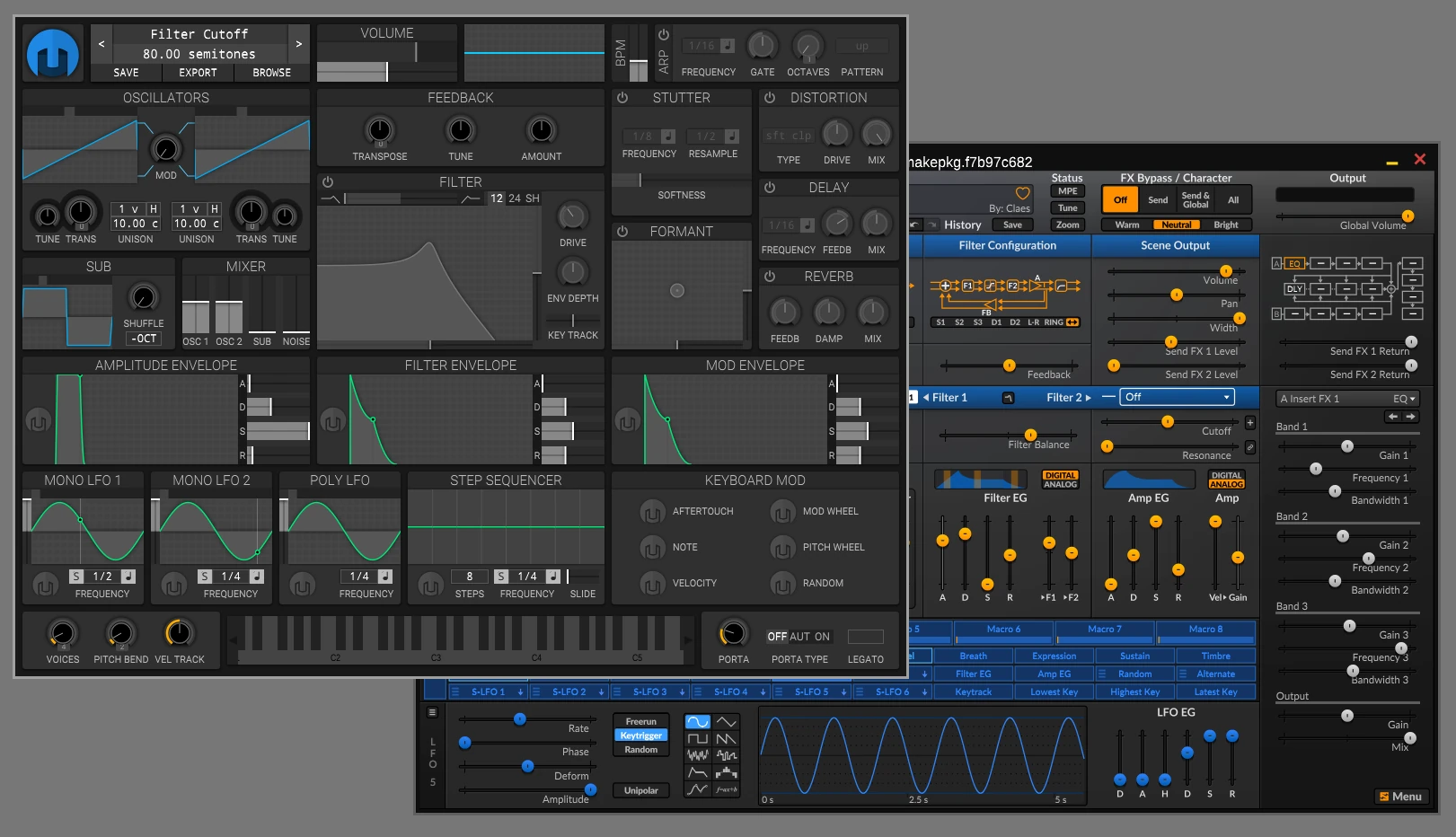
Isaac helped out again by recommending Carla which is a host for DAW plugins without actually being a DAW. It also loads very fast compared to other audio applications.
It seems like most audio applications index and load all plugins on
startup. Now, I have installed the pro-audio meta-package on Arch,
which comes with an insane amount of such plugins. This makes some
audio applications take ages to load. For exmaple, audacity (and its
various forks) take over five minutes just to launch!
Carla is way faster. I strace'd around a bit and assume that carla
just indexes the directories where plugins commonly live and only
loads the ones you explicitly open, while audacity actually loads all
of them on startup.
Both Helm and Surge XT have a plug-in version, so I can use them within Carla, which allows me more advanced MIDI routing.
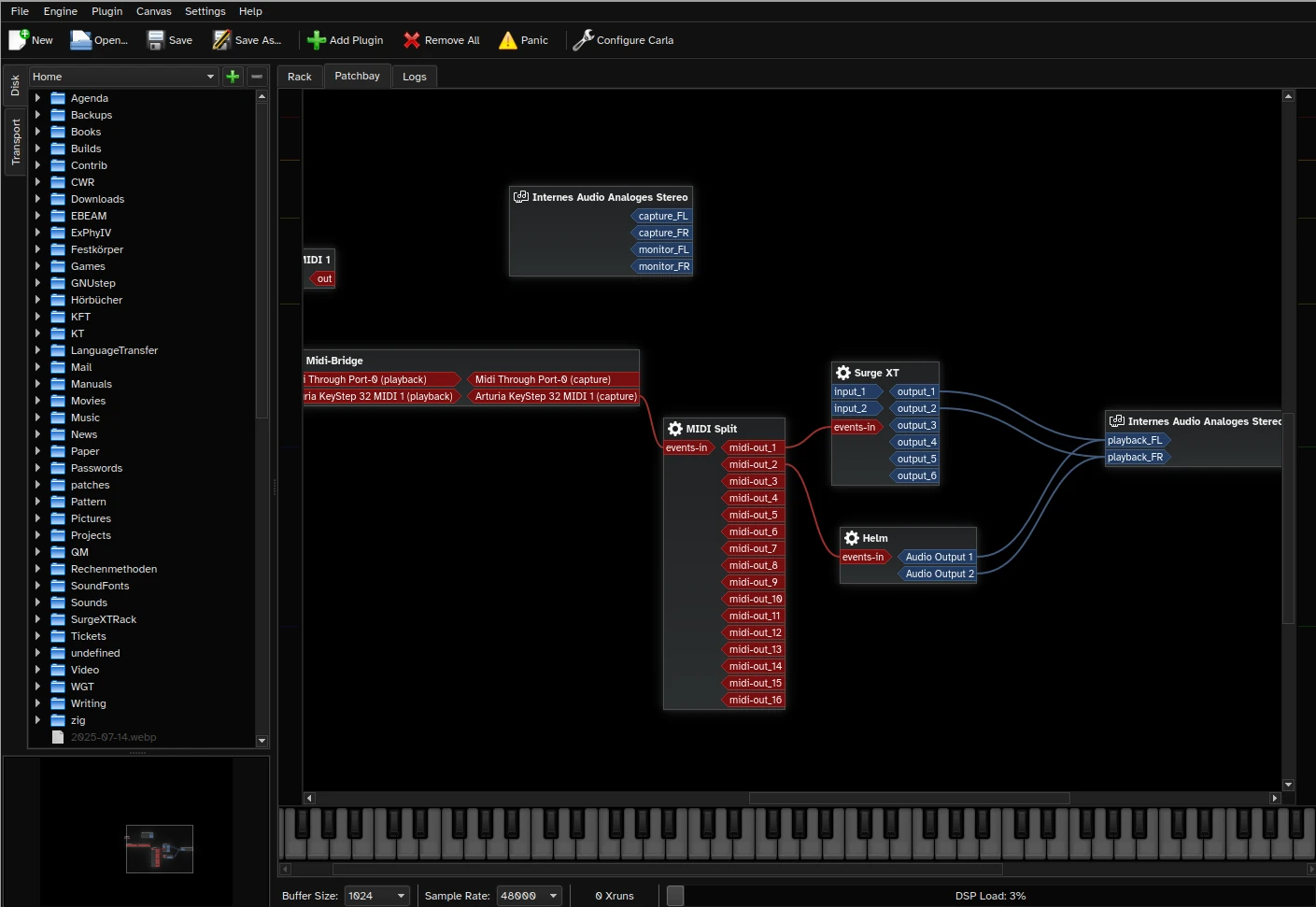
In Carla I also discovered the JuceOPL synth, which sounds pretty nice.
Synths are not the only plugins Carla can load. So I did experiment with different audio effects / filters. There is this one plugin which simulates a eurorack modular synth in its UI, with patch cables and all that stuff.
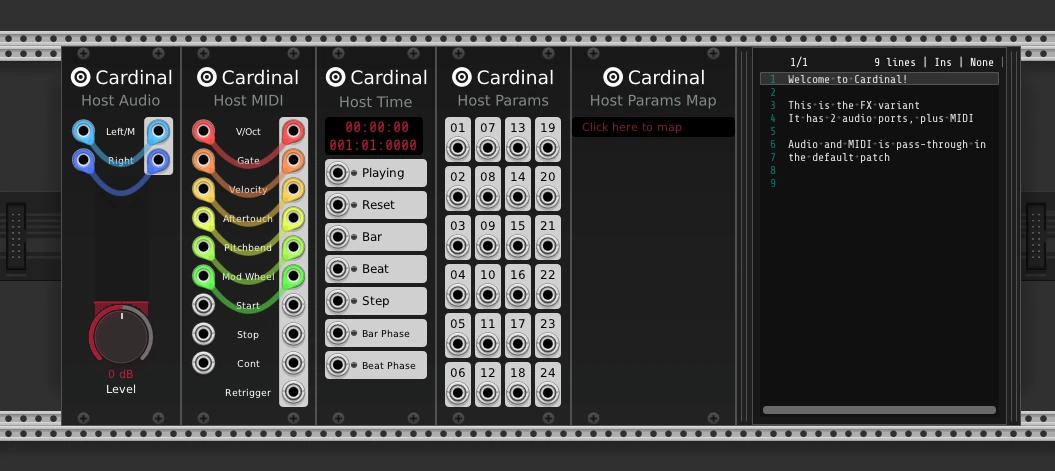
Oh no, this is just nested menus with a different skin, isn't it?
This plugin in turn has many plugins of its own, many of which mirroring features found in other filters I tried in carla. And honestly I feel even the UI itself is pretty redundant with Carlas too: Both simulate plugging patch cables between audio and MIDI things, just one has a skeumorphic style while the other has a more abstract design.
At this point I was about to write something like "I wish this was a standalone thing so I could just skip Carla, avoiding having too many nested redundant components." when I thought, surely it can't be just a plugin. And it isn't! There is a standalone version! You just have to install it!
Since I discovered it literally just now at the time of writing this, I have no idea how this integrates with pipewire and MIDI devices and all that stuff. Although it is shown in my preferred pipewire patch editor (Helvum) so there is a decent chance this might actually be simple. I just had a quick look and discovered that you can't integrate any of the three synths I experimented with so far into it, but I guess it probably has its own? This needs further research.
Either way, this thing completely solves the nested menu problem for me, because there are no "levels" of UI to descend into: All configuration is done directly on the "faceplates" of the modules, no popups or menus or anything like that. It even launches in a reasonable amount of time!
Maybe it can make me like doing synths on my laptop after all?
Ok, I played around with it for a few minutes: It is tremendously good at being a modular effects unit you can plug in the middle of any pipewire audio stream, which has many neat applications, maybe. It is more complicated if you want synth sounds, because there doesn't seem to be a straight-up synth module, rather you have to understand how to build up a synth out of eurorack stuff. It not so great at MIDI stuff, it seems to lack the advanced routing Carla can do; But for simple things it might be enough.
Carla even allows me to split MIDI signals based on note range: So for example I could configure the right half of the Keysteps keyboard for one synth and the left for another. This in turn also allows it's sequencer to control multiple synths. Pretty neat!
Unfortunately both Carla and Helm are a bit crashy and Carla also suffers from a very menu-ish UI.
Oh no, all of this is a lot of computer for a thing I wanted to keep computer out of…
More Synths!
I scored a Roland D-110 for a very reasonable price. So reasonable in fact, that I could justify to myself that picking it up with only about an hour of reading up on it and its quirks made sense. I payed basically nothing for it.

The D-110 is a rackmount synth. It has multiple polyphonic voices (is that the right terminology?) which can all be programmed to different MIDI channels. There are a few hardcoded configurations for those voices as you'd expect, but you can program your own as well. It also has built-in drum samples, so I get the classic Roland drums after all!
I find the drum samples go really well together with the analog synth drums of the Drumbrute Impact. For exmaple I like the sampled kick combined with the synthesized kick, where the latter is set to a lower pitch and longer reverb.
The two drum sounds compliment each other really well.
By virtue of being a rackmount synth it is a bit lacking in UI. To be more clear, it is menu-hell. The only thing worse than menu-hell on a computer is menu-hell on a device with a small screen and context-dependent buttons… Forget programming your own sounds using the menu. It's annoying enough to use even one of the preconfigured ones already. There is a control unit for the D-110. Which I, of course, do not have. It can control all the settings. Via MIDI! Did you know MIDI can send arbitrary data, not just notes? I didn't!
Now, after giving up on programming sounds via the clunky menus, I thought surely if this thing is controlled via MIDI, I can control it from a computer using a MIDI interface. And turns out I can!
I eventually found EdiSyn. It's a patch editor for a fair collection of synths and the D-110 is among them.
It's not a very fluid program: If it uses a MIDI interface, nothing else can talk over that interface. And it needs to be a "fresh" connection: If anything else has used the MIDI interface, it won't work and you have to re-plug it. Also it comes with all the annoyances any Java GUI is plagued with.
Either way I am grateful it exists. Even if it might eventually annoy me enough to write my own thing which does not come with these problems…
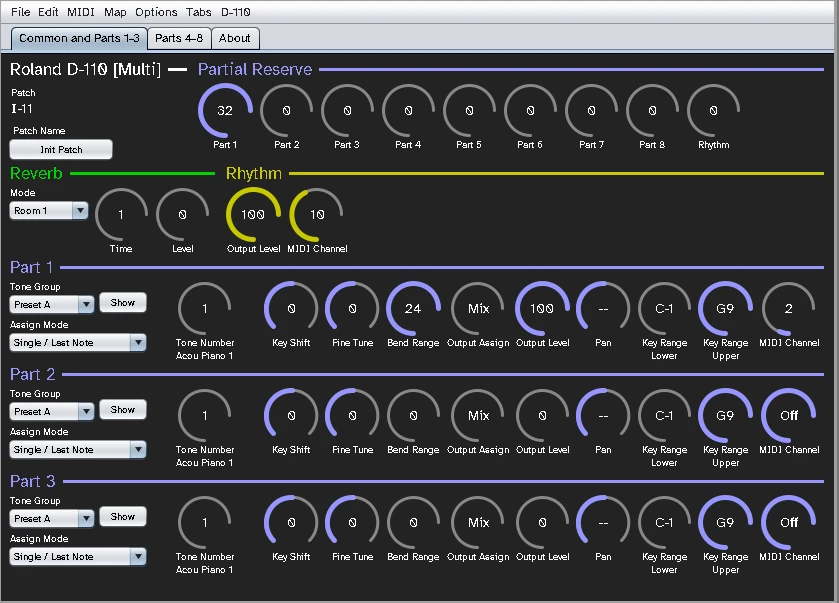
Edisyn can also change the MIDI channel of the D-110s percussion bank. It defaults to 10, as all MIDI percussion things do, just like the Drumbrute Impact. I set it to 11, so that I can use both drums at the same time without conflict.
Oh no, there still is some computer in my synth…
The Keystep can double as a USB MIDI interface, if you set the right setting. Unfortunately, it doesn't work with Edisyn, somehow. I suspect it might strip out the MIDI control signals? Maybe? No idea. I did not investigate this much further, because the audio interface I got to mix both the D-110 and the Drumbrute Impact together also has a built-in MIDI interface, which worked pretty fine.
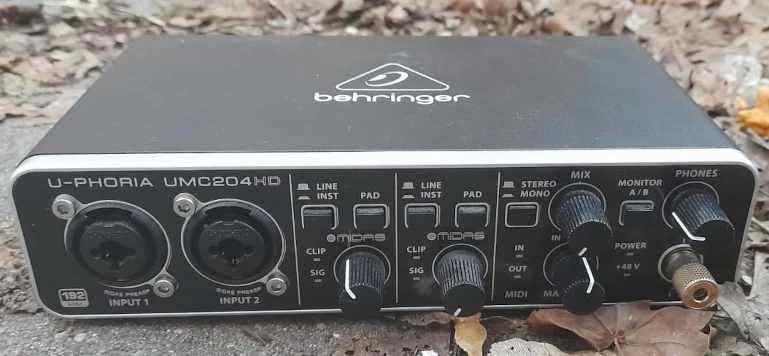
I did not mention the interface before, but I guess I have to now: It is one of those Behringer ones and it is pretty shit. To give you an idea of its quality, or lack thereof: If you lower the volume on the headphone output, eventually the right side will cut out before left.
I guess apparently when people online scream "Do not buy a dedicated headphone DAC/Amp, just get an audio interface! It's just as good but cheaper!" they are lying? Never had any issues with my dedicated DAC. Other than the major issue of my taste in music shifting from metal to darkwave, which doesn't benefit from high fidelity quite as much, so it going unused for about a year now, of course.
Setup
As a quick intermission, I guess this is the part were I tell the anectdote of my setup?
So, since I don't actually do any work at home anymore, my desk is pretty useless. So I thought it's the perfect place for my synth setup. I spend a fair amount of time wrangling all the cables and rearranging everything into a nice decent setup.
I never used it.
Apparently to my brain, my desk and the concept of fun are incompatible? Also I made the massive mistake to repurpose my old workstation as the dedicated synth computer, since I apparently need that after all: All that was missing was for me to install a drive and an operating system, which I never found the motivation for in all the weeks that setup existed.
So I ripped out the synths and put them all on my coffee table with my laptop. The cabling is a mess and it's pretty impossible to sit at it comfortably, but unlike my perfect desk setup, this is actually fun?
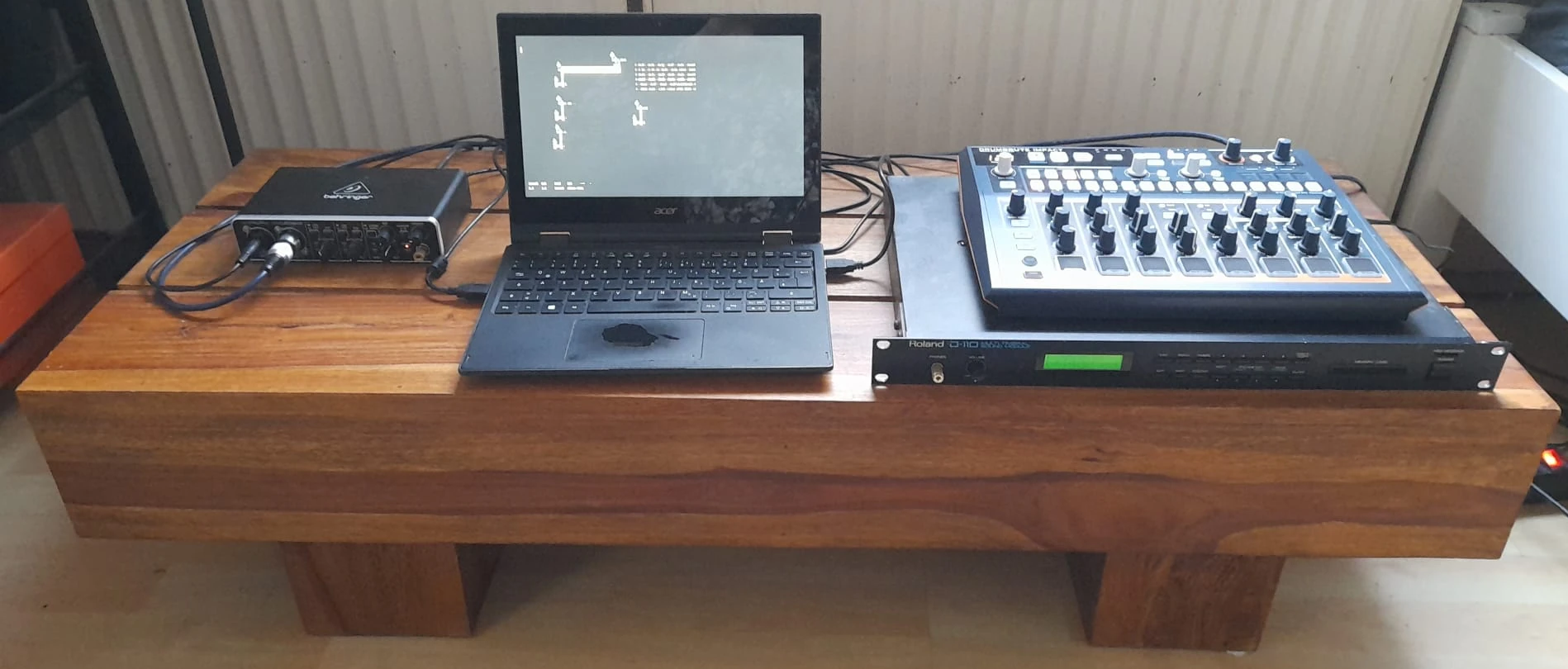
I should probably just get rid of my desk, the last time I've actually properly used it was almost two years ago. It's apparently not useful for fun and even for Serious Computering™ I also just prefer lounging in my reading chair with my laptop.
Wait, why is the Keystep missing in that picture? Find out in the next section!
Orca
I did not get very far with the sequencing power of the Keystep. It's fine for simple basslines, but that's about it. Then I remembered Orca exists. An esoteric, two-dimensional programming language, meant to drive MIDI synths? Count me in!
Again with the computers…
For all the hours I've put into Orca, it's pretty hard to write much about it. But I'll try.
It combines my inherent interest in arcane problem solving with my
interest in Beep-Boop-Machines synthesizers. Want to play a
sequence of notes? Congrats, now your brain is occupied with trying to
do that in the most elegant / simple / smallest way possible.
There are some issues I have with it: I find the setting for the
length of the notes pretty useless. Only the shortest possible note
you can play is useful, all others are just way to long. Even a value
of 1, which is supposed to be the second shortest note, already
plays for an entire bar.
So it's a bit hard to purposefully create anything melodic with Orca, it's not the best sequencer (Also have I mentioned that I am not a particularly good or creative composer?). But that is offset by all the weird things you can do with procedurally / algorithmically generated or even fully random sequences! I might never use Orca for a "proper" song (well, I might never create a proper song full-stop) – I'd go looking for a better sequencer for that – but I don't think anything else could be this fun!

Unfortunately, this means at the moment I do not have a use for the Keystep.
Fun fact: Unlike I initially thought, you can't use the Drumbrute Impact as a MIDI interface, despite its own internal intruments being controllable via USB-MIDI and its sequencer being able to send MIDI. Searching online I found a forum thread which makes it sound like this is just a missing firmware feature. But apparently it never got added? A bit weird, because it seems like such an obvous thing.
This actually makes my setup a tiny bit more complicated, because now I have to use the Behringer to control the D-110 with Orca. Meaning I need to tell Orca to output MIDI to some virtual sink which I then wire up in Helvum to both the Drumbrute Impact and the Behringer.
Ok, somehow I did end up with a computer again. But I don't really mind. Probably because it's fairly esoteric? Since my laptop is now necessiraly part of the setup, I may end up experimenting with software synths again. Maybe. At least if I can do that comfortably, meaning without fun-killing software.
Conclusion?
Let's make this quick…
| Thing | Would I recommend it? |
|---|---|
| Arturia Drumbrute Impact | Yes, lots of fun, good sounds, good UI/UX, easy to get into, works well both standalone and as part of a bigger setup. |
| Arturia Keystep | Not if you want a sequencer. As a pure MIDI keyboard it's fine. |
| Behringer U-Phoria | No. |
| Roland D-110 | Yes, if you can get one cheap and with its control unit. |
| Carla | Yes, although it might be crashy for you too. |
| SysEx Controls | Yes. Good software, no notes. |
| Edisyn | Yes. A bit clunky, but it works and I am not aware of any alternatives. |
| Helm, SurgeXT, JuceOPL | Yes. Neat synths, although Helm is a bit crashy. |
| Orca | Yes. Way more fun than it has any right to be. And surprisingly easy to pick up. |
| Cardinal | Yes. Only played with it for a bit, but seems like it holds a few hours of fun inside. |
And so I did end up with a computer-related interest again… damnit!